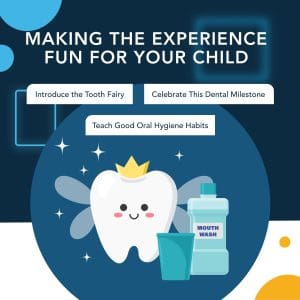Your child’s first loose tooth is an exciting milestone, but it can also bring questions and concerns. Should you let it fall out naturally or help it along? Is a little bleeding normal? How can you make the experience fun and stress-free? Understanding the tooth loss process will help you guide your child through this transition with confidence. From loose tooth care to celebrating the moment, here’s everything you need to know to make it a positive experience!
Why Do Baby Teeth Become Loose?
Baby teeth become loose as part of the natural tooth loss process, making way for permanent teeth to emerge. This usually starts around age 5-7 when the roots of baby teeth begin to dissolve, allowing them to loosen and fall out. The process is gradual and painless for most children, though some may experience mild wiggling discomfort. Proper oral hygiene and patience help ensure a smooth transition as their new teeth grow in.
Signs Your Child’s Tooth Is Ready to Fall Out
As your child’s baby tooth becomes loose, there are clear signs that it’s nearing the point of falling out. The process is typically painless, but some children may experience mild discomfort or sensitivity. Changes in how they eat, speak, or handle the wiggly tooth can indicate it’s almost ready. Paying attention to these cues will help you know when to step in, or when to let nature take its course.
Increased Movement of the Wiggly Tooth
As a baby tooth nears the end of its journey, it will become noticeably looser. At first, it may wiggle slightly when your child touches it, but over time, it will shift more easily in all directions. If the tooth can twist or nearly come out on its own without discomfort, it’s a strong sign that it’s ready to fall out soon.
Slight Bleeding or Soreness Around the Tooth
A little bleeding or mild soreness is common when a tooth becomes loose. As the root dissolves and the tooth loss process progresses, gums may appear slightly red or irritated. This is usually nothing to worry about and stops quickly, especially with gentle care. If bleeding is excessive or persistent, it’s best to check with a pediatric dentist near me.
Changes in How Your Child Eats or Talks
Your child may instinctively adjust how they chew or speak when a wiggly tooth becomes more noticeable. They may avoid using that side of their mouth while eating or mention that certain foods feel uncomfortable. Some children may even develop a slight lisp as they navigate speaking with a loose tooth, a temporary change that will resolve once the new permanent tooth comes in.
New Tooth Growth Appearing Beneath the Baby Tooth
One of the clearest signs that a baby tooth is ready to fall out is the appearance of a permanent tooth pushing through the gums. Sometimes, the new tooth emerges before the old one has fallen out, making the baby tooth feel even looser. In most cases, the new tooth growth will naturally encourage the old tooth to come out, but if it lingers too long, a Davie dentist may need to assess the situation.
What to Do When Your Child Has a Loose Tooth
When your child has a loose tooth, it’s important to guide them through the process safely and comfortably. While it can be tempting to speed things up, patience is key to preventing pain or irritation. Encouraging gentle handling, maintaining good oral hygiene, and knowing when to step in can make the experience smoother.
Encourage Gentle Wiggling
Letting your child gently wiggle their loose tooth can help it fall out naturally without discomfort. Encourage them to use their tongue or clean fingers to move it slightly, but remind them not to force it. Excessive pulling or twisting too soon can cause gum irritation or pain. Patience ensures a smoother, pain-free tooth loss process.
Should You Pull the Tooth or Let It Fall Out Naturally?
It’s usually best to let a wiggly tooth fall out on its own. If it’s barely attached and painless when tugged, you can assist with pulling the tooth gently using a tissue. However, forcing it too soon can damage healthy gums and lead to bleeding. If the tooth isn’t quite ready, encourage more wiggling and let nature take its course.
How to Handle Bleeding After the Tooth Falls Out
Some bleeding is normal when a baby tooth comes out. Have your child bite down on a clean tissue or gauze for a few minutes to stop it. Avoid rinsing vigorously, as it can prolong the bleeding. If bleeding gums persist for more than 10-15 minutes, apply gentle pressure and consult a pediatric dentist if necessary.
Keeping the Area Clean After Tooth Loss
After a tooth falls out, keeping the area clean helps prevent irritation and infection. Encourage your child to rinse with warm water and continue brushing gently around the gap. Avoid harsh scrubbing or touching the area too much. Keeping up with oral hygiene ensures that the gums heal properly and are ready for the new tooth growth.
Making the Experience Fun for Your Child
Losing a baby tooth is a big milestone for kids, and turning it into a fun, exciting experience can help ease any worries. Whether it’s celebrating with the tooth fairy, marking the occasion with a special tradition, or simply offering encouragement, making the moment positive helps build confidence. A little creativity can turn a wiggly tooth into a cherished memory, reinforcing good oral hygiene habits along the way.
Introduce the Tooth Fairy
Bringing the tooth fairy into the experience can make losing a wiggly tooth exciting instead of scary. Create fun traditions like leaving a tiny note, a sprinkle of glitter (“fairy dust”), or a small surprise under their pillow. Encouraging their imagination makes the tooth loss process magical while reinforcing positive emotions around their dental milestone.
Celebrate This Dental Milestone
Losing a baby tooth is a special moment, so make it feel like an achievement! Mark the occasion with a tooth loss chart, take a fun photo, or let your child choose a small reward. Acknowledging their new tooth growth as an exciting step toward growing up helps them feel proud and eager for good oral hygiene habits.
Teach Good Oral Hygiene Habits
Losing a tooth is the perfect time to reinforce the importance of oral hygiene. Encourage your child to brush and floss regularly, explaining how it keeps their permanent teeth strong and healthy. Let them pick out a fun toothbrush or flavored toothpaste to make dental care more exciting. Establishing good habits early ensures a lifetime of healthy smiles!
When to See a Pediatric Dentist
While most loose teeth fall out naturally without issues, some situations may require a visit to a pediatric dentist. If a tooth becomes loose too early, refuses to fall out, or causes pain and swelling, professional guidance can help ensure a smooth tooth loss process. Knowing when to seek dental care can prevent complications and keep your child’s oral health on track.
If a Tooth Becomes Loose Too Early
If a baby tooth becomes loose much earlier than expected, especially due to an accident or injury, it’s important to see a pediatric dentist. Losing a tooth too soon can impact the alignment of permanent teeth and may require intervention. A dentist can assess the situation and recommend the best course of action to protect your child’s oral health.
If a Loose Tooth Won’t Fall Out
Most wiggly teeth will eventually fall out on their own, but sometimes a stubborn tooth lingers longer than expected. If a loose tooth remains in place while the new tooth growth is visible or if your child complains of discomfort, a pediatric dentist can determine whether removal is necessary. Delayed tooth loss can sometimes affect proper alignment and spacing.
If New Teeth Are Growing Behind Baby Teeth
Sometimes permanent teeth begin to grow in before the baby tooth has fallen out, leading to a “shark tooth” appearance. While this often resolves on its own, a pediatric dentist should evaluate if intervention is needed. If the baby tooth isn’t loosening naturally, a dentist may recommend extraction to prevent crowding and ensure proper tooth alignment.
If Your Child Experiences Pain or Swelling
A loose tooth shouldn’t cause severe pain or persistent swelling. If your child complains of discomfort, redness, or inflammation around the tooth loss area, it may be a sign of infection or another dental issue. A pediatric dentist can assess the situation and provide treatment to prevent complications, ensuring your child’s dental milestone is a smooth and painless experience.
Schedule Your Next Dental Checkup Today
Regular dental checkups are essential for keeping your child’s oral health on track, especially during the tooth loss process. A pediatric dentist in Davie, Florida can monitor new tooth growth, ensure teeth are falling out at the right time, and address any concerns like stubborn baby teeth or tooth sensitivity. Routine visits also help reinforce good oral hygiene habits and prevent future dental issues. Schedule your child’s next checkup today to make sure their smile stays healthy and strong as they transition to permanent teeth!
April 4, 2025

 Adult
Adult



